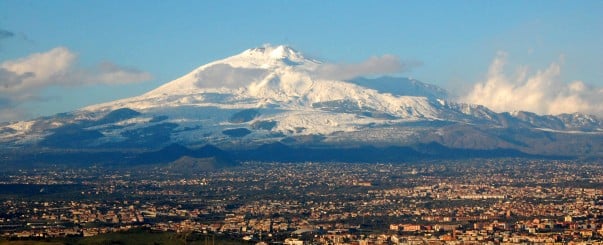Mount Etna, at an elevation of over 10,900 feet, is the most prominent site in the island of Sicily in the Mediterranean Sea. Located on the eastern part of the island near Catania, 10 miles away, the Montebello (as it is known among the locals; and meaning a beautiful mountain) is considered among the most active volcanic mountains in the world. It is a stratovolcano with four distinct volcanic openings or ‘summit craters’ – two in the center, one in the northeast and another in the southeastern side. Etna has experienced numerous eruptions for the past 500,000 years, the most recent being on 15-20 march, 2017, during which airplanes were stopped from flying in the vicinity.
Despite its active volcanic state, Mount Etna attracts global tourists to witness the flaming-smoking eruptions, and the bubbling-hot lava streaming from a distance. This mountain in Sicily is famous for its hiking trails and snow-skiing as well. Its breathtaking landscape leaves an everlasting mark in every tourist’s mind.
Interesting Facts about Mount Etna
Mount Etna is a favorite subject for volcanologists, geologists and other scientists. It is in fact well documented for the longest time (since 1500 BC). This makes the scientists’ learning of the tectonic activities on earth insightful. Situated on the conjunction between the Ionian microplate and African plate, geologists believe the constant subduction of these plates below the Eurasian plate make the volcano of Mount Etna highly unstable. They are believed to be the reason for its continuous eruption since 2007. The longest ever has been for 13 years from 1979 to 1992.
The most destructive volcanic activity by Mount Etna was considered to be in 1669, when the pyroclastic flows ruined several villages and towns in Sicily. Catania was also affected by the lava flows. People tried diverting the lava to the other side, but this affected the town of Paterno, who made them abandon the diversion. Another attempt at harnessing the lava flows occurred in 1992, when the US Marines got involved. They dropped blocks of concrete at the edge and into the mouth of the lava tunnel using helicopters. This attempt was officially called as ‘Operation Volcano Buster’. Even though the blocks slowed the flow, the lava eventually ruined the agricultural farms and houses on its way.
Valle del Bove
While riding the cable car up and down the mountain in the eastern slope, you can notice a depression shaped like a giant horseshoe. This deep-canyon-like feature is known as the Valle del Bove, literally meaning the ‘Valley of the Ox’. An interesting fact about this awe-inspiring lava-filled valley is that it was formed about 64,000 years ago due to a series of collapses of volcanic craters that were predecessors to the current ones in Mount Etna.
Smoke Rings
Volcanoes rarely send out smoke in the form of rings. Mount Etna is famous for emitting smoke rings a number of times in history. The first time it was recorded was in the 1970s. The most recent one was between 15-20 march, 2017 . Other volcanoes that are known to emit smoke rings include Mount Aso in Japan, Stromboli in the Aeolian Islands in Italy, and Mount Redoubt in Alaska in the US.
Also Read : Aeolian Islands
Mustafar
A Star Wars fan knows that this is not a real place in or around Mount Etna. It is a fictional planet in the Star Wars world that George Lucas created, and which he depicted using images of Mt Etna’s volcanic eruption. He used footage of the exploding Mount Etna to show the fiery and volcanic nature of the ‘Mustafar’ planet. You can see this in the movie ‘Star Wars Episode III: Revenge of the Sith’.
Mount Etna Broom
Mount Etna Broom (Scientific name: Genista aetnensis) is a tree endemic to the lower slopes of Mount Etna. It looks like a large shrub with small yellow colored flowers with a sweet smell. You can also see them in the horticultural gardens and landscaped parks in and around Mount Etna.
Related: Major Volcanoes in the world | Most Active Volcanoes On the Planet
Image Credit : BenAveling

